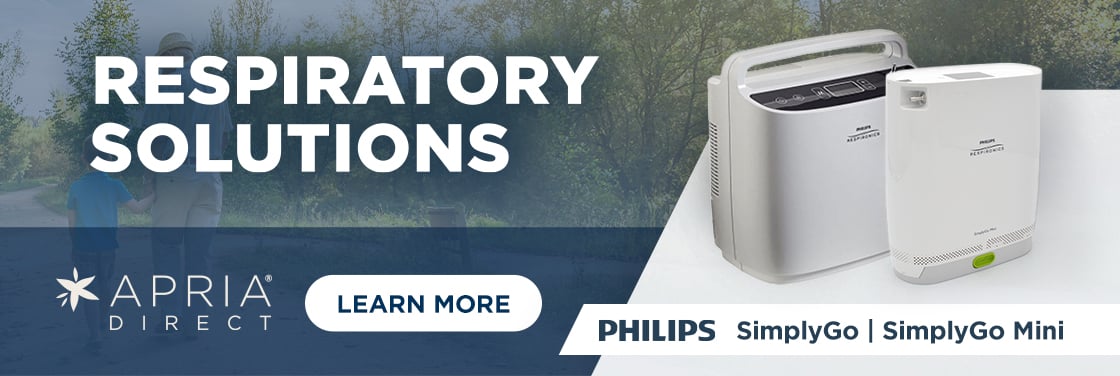Setting the Record Straight About Oxygen Therapy
People with COPD (chronic obstructive pulmonary disorder) and other lung diseases struggle to get enough oxygen on their own. Although not a cure, oxygen therapy (also called supplemental oxygen) is a proven effective treatment to deliver oxygen throughout the body, which helps:
- Increase energy levels
- Enhance sleep
- Make breathing easier
- Improve the quality and length of life
Although oxygen therapy has been used for well over a century and has been extensively studied, there are still numerous misconceptions about it.
Let’s debunk the myths and reveal the truths about oxygen therapy.
Myth 1: “I’ll Need Oxygen Therapy 24/7 for the Rest of My Life”
Fact: We all need oxygen 24/7! You just need a little more than what is in the room air. Everybody is different. Some people need oxygen therapy 24 hours a day. Others require it only during certain activities, such as sleeping or exercising. Many people with COPD may need supplemental oxygen for life, but each case is unique, and your doctor will prescribe how you should use oxygen therapy. To get the most out of your oxygen therapy and feel your best, it’s critical that you follow your doctor’s orders!
Myth 2: “Oxygen Therapy Always Relieves Shortness of Breath”
Fact: Oxygen therapy very effectively relieves shortness of breath (hypoxia)—but not always. Muscles require oxygen to perform the task at hand. Breathing itself requires muscle strength which can lead to shortness of breath, even while sitting.
Weak and tired muscles also must work harder to deliver oxygen, which makes breathing more difficult.
Plus, some people require a combination of therapies to help relieve shortness of breath. Your doctor will prescribe the most appropriate treatment for you.
Myth 3: “I Can Become Addicted to Oxygen”
Fact: Although oxygen is classified as a drug and regulated by the FDA, it is not addictive. If you discontinue your oxygen therapy, your oxygen levels may decrease, but you will not have uncontrollable cravings and withdrawals.
Because oxygen is a drug, your doctor will give you a prescription that includes your appropriate oxygen flow rate, which is the amount of oxygen that is delivered each minute by the device you are using.
Myth 4: “Oxygen Therapy Prevents Me from Traveling”
Fact: You certainly can travel. But it’s important to plan ahead:
- Make sure you have all your oxygen therapy supplies. You can speak with your doctor or the specialists here at Apria to arrange for supplies to be available at your destination.
- If you are flying, the FAA now allows you to carry on a portable oxygen concentrator. (Some airlines also offer in-flight oxygen.) Be sure to alert the airline that you will be flying with portable oxygen.
- Refill all your medications. Make sure you have enough to last the whole trip.
- Pack your medical records. And keep them handy, including a recent prescription for your oxygen.
For more information: Traveling with Oxygen Therapy.
Myth 5: “Oxygen Therapy Means I’ll Be Confined at Home”
Fact: Not at all. Lightweight, portable oxygen concentrators and liquid oxygen allow you to leave your home to do errands and even travel.
You can also purchase accessories like carrying cases and carts so your oxygen therapy can go wherever you go.
Myth 6: “I Can’t Exercise and Use Oxygen”
Fact: Yes, you can—and should.
Some of the best exercises for people with COPD include stretching, aerobics, and strength training.
For more information: Reduce COPD Symptoms with Exercise.
Myth 7: “Oxygen Therapy Consists of Big, Bulky Equipment
Fact: Portable oxygen delivery systems are available in a variety of styles and sizes and can weigh as little as 5 pounds. Some have wheels, some are designed like purses you can wear over your shoulder, and most are battery-operated for even greater portability.
Myth 8: “I Can Use a Portable Oxygen Concentrator All the Time”
Fact: Although portable oxygen concentrators (POC) are available, these devices aren’t appropriate for people who need continuous flow or higher oxygen flow rates. Additionally, using a POC while sleeping is not recommended for everyone.
Myth 9: “Oxygen Is Flammable”
Fact: Even though oxygen itself isn’t flammable, it is combustible. That means it can cause other materials to ignite more easily and burn more rapidly.
That’s why it’s important to keep your oxygen delivery devices away from places where there’s fire or excessive heat, such as in the kitchen when you are cooking or near fireplaces, wood-burning stoves, candles, space heaters—even toasters and toaster ovens. And never smoke near oxygen.
Aerosol sprays containing combustible materials and items containing grease, petroleum, or oil ignite easily, so store them away from oxygen. Also, refrain from using lotions and face creams that contain oil or petroleum while wearing your oxygen.
For more information: How to Store Oxygen Safely at Home.
Myth 10: “Petroleum Jelly Eases Nasal Dryness”
Fact: As stated above, oxygen can make materials like petroleum burn faster and hotter. Instead, use water-based products to help with nasal dryness.
References
1. (2023, May 5). Oxygen Therapy. American Lung Association. https://www.lung.org/lung-health-diseases/lung-procedures-and-tests/oxygen-therapy.
2. (Updated 2022, June 6). Oxygen Therapy. Cleveland Clinic. https://my.clevelandclinic.org/health/treatments/23194-oxygen-therapy.
3. Stubblefield, H. (Updated 2017, July 9). Oxygen Therapy. Healthline. https://www.healthline.com/health/oxygen-therapy.
4. Dumain, T. (2022, September 1). Home Oxygen Therapy: What to Know. WebMD. https://www.webmd.com/lung/lung-home-oxygen-therapy.
5. Orenstein, B. (2023, June 27). 5 COPD Myths That Can Actually Make You Sicker. Everyday Health. https://www.everydayhealth.com/conditions/copd-myths-that-can-make-you-sicker/.
6. (2018, February 19). The 12 things every home oxygen user should know. Lung Foundation Australia. https://lungfoundation.com.au/news/the-12-things-every-home-oxygen-user-should-know/.
7. Swigris, J., Mullen, A. (2017, September). Busting Myths About Oxygen Therapy. National Jewish Health. https://www.nationaljewish.org/conditions/health-infographics/busting-myths-about-oxygen-therapy.
8. (2006, April 1). AAHomecare Busts Myths About COPD and Oxygen Use. HME Business. https://hme-business.com/aahomecare-busts-myths-about-copd-and-oxygen-use/.
LEGAL DISCLAIMER: Material in this newsletter is provided for general health education and informational purposes and to provide references to other resources only; it may not apply to you as an individual. While Apria Healthcare believes that the information provided through this communication is accurate and reliable, Apria Healthcare cannot and does not make any such guarantee. It is not intended to be a replacement for professional medical advice, evaluation, diagnosis, services or treatment (collectively, “medical treatment”). Please see your healthcare provider for medical treatment related to you and your specific health condition(s). Never disregard medical advice or delay seeking medical care because of something you have read on or accessed through this website. Reading this newsletter should not be construed to mean that you have a healthcare provider/patient relationship.





.png)
